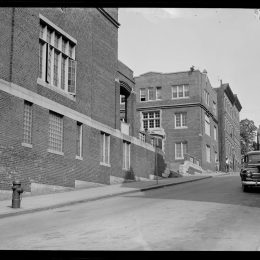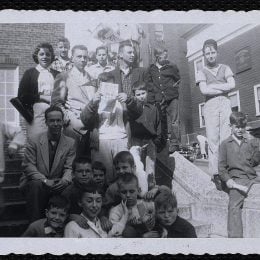
“Believe with me in the rebirth of tragedy. Socratic man has run his course [and we are entering into a new era]. Crown yourselves with glory and embrace the fertility that Nature is about to bestow through you. And do not be surprised when your demons themselves ascend into Heaven. Turn your back on your Ego and remain true to your Self, and you will be redeemed. You are the ones who will lead the tiger and panther out of India and back into Greece. You are the ones who will lead Man back to Nature. Prepare yourself for a severe conflict. But have faith in your belief in miracles.”
Friedrich Nietzsche,
The Birth of Tragedy §20,
(reiterated and appended by James Chester)
James Chester is an American philosopher. He was the first philosopher to crack Friedrich Nietzsche’s enigmatic chef d’oeuvre, Thus Spoke Zarathustra, when he identified it as a dithyramb, a literary representation of human will and the first since Plato, who was the last philosopher to compose in the dithyramb. He then taught himself how to read dithyrambic music and how to practice dithyrambic drama. Fifty years later, he became the first person to complete Nietzsche’s dithyrambic drama, which, in fact, is a dithyrambic tragedy that offers its readers an experience, not just a conceptual theory, of proto-tragedy. As it turns out, proto-tragedy is an integral step in a process of growth by which the subconscious is incorporated into the conscience for the purpose of redeeming the bad conscience and thereby ascending unto a state of enlightenment that Nietzsche called Übermensch, wherein all suffering is made meaningful and worthwhile.
Books in Print by James Chester

From the Back Cover of the Birth of Dionysia
In the nineteenth century, the German philosopher Friedrich Nietzsche solved a mystery that had baffled Western philosophers for more than two thousand years. Why did the ancient Greeks celebrate the destruction of magnificent individuals in their tragedies, which was an art form they themselves invented? Something very special lay waiting to be discovered in this mystery, like a jewel atop the crown of ancient wisdom, because the ancients had produced a progeny of extraordinary individuals that marked the only time in all of history when genius was common, not rare. Having cracked that nut, and being the only one who did it, at the end of his life, Nietzsche then wrote his magnum opus, Thus Spoke Zarathustra — and no one understood a word of it. In fact, Nietzsche’s masterpiece is a new art form, which is called the New Dithyramb, and Thus Spoke Zarathustra is the modern world’s only dithyrambic tragedy. The Birth of Dionysia aims to teach the college student how to read a dithyramb and how to practice dithyrambic drama so that he or she may then experience tragedy as it first appeared at the dawn of civilization and share in the very rare secret that tragedy does not destroy man but rather heals him. Available for purchase on Amazon (new window).

From the Back Cover of the Dionysia Metaphysica
Dionysia Metaphysica is a reiteration of The Birth of Tragedy by the German philosopher Friedrich Nietzsche. Nietzsche entitled the first draft of The Birth of Tragedy (BT) as “The Dionysian Vision of the World.” Dionysia Metaphsyica presents a reiteration of BT as, indeed, a view of the world, specifically the inner world of man, which is a metaphysica. BT is not Nietzsche’s scholarly view of ancient Greek culture during the time in history when the practice of tragedy arose as a new art form. But most books about BT have focused precisely on this scholarly view. Viewed instead as a metaphysica, and using a translation of Nietzsche’s original writing word for word and in full, this reiteration elucidates a theory of life within human being as art in the form of mythopoeia, or the creation of Self, founded on a process of growth arising out of an evolutionary interplay between the two realms of sensation and ideation. It also provides valuable insight into Nietzsche’s invention of a new art form, called dithyrambic drama, as a vehicle with which to achieve a true representation of tragedy and therewith resurrect the practice of tragedy. As such, the reiteration also provides insight into how to read a dithyramb and how to practice dithyrambic drama for the purpose of undertaking the world’s only dithyrambic tragedy, Thus Spoke Zarathustra, which Nietzsche wrote. Available for purchase on Amazon (new window).

From the Back Cover of Nietzsche on Dithyrambic Music
Nietzsche on Dithyrambic Music presents the theory that Nietzsche’s magnum opus, Thus Spoke Zarathustra, is a dithyrambic tragedy, that it is composed in the dithyramb, and that it represents the world’s only existing composition of dithyrambic music.
Nietzsche invented dithyrambic drama. It is an entirely new art form in which no one has any experience whatsoever. It is so new, so unfamiliar, and so foreign that no one has even figured out how to read it. After its publication in 1883, it quickly became a literary enigma and remained that way for more than a century, until now, in 2021.
In fact, Thus Spoke Zarathustra is a “map” of an inner drama, a willful contest, between the conscience and those parts of it that have turned bad. And learning how to read that map requires an education, which I have tried to provide with two earlier publications, The Birth of Dionysia (2020) and Dionysia Metaphysica (2020).
In this publication, my goal is to explain a concept of dithyrambic music, which is, in fact, a manifestation of music as we know it but, in this very unusual instance, in literary form. And just as someone who cannot read music would never be able to render the notes in a musical composition, neither would a reader who cannot read dithyrambic music render it sensible either. This book attempts to teach you how to read dithyrambic music. Available for purchase on Amazon (new window).

Coming in 2025
Nietzsche on History and Supra-History is a reiteration of Nietzsche’s essay entitled On the Use and Abuse of History for Life, from the volume entitled Thoughts Out of Season, Part II. What it tries to explain is that old beliefs (or history) and the pursuit of knowledge purely for the sake of knowledge (or science) can deeply injure life by severing its spearhead, which is art. What Nietzsche tries to impress upon his readers in this book is that art is absolutely essential to life. And he defines art specifically as mythopoeia, or the creation of Self. What is most valuable about this essay is its clarification of Nietzsche’s exact notions of history and science and art and, in the end, supra-history.
For Nietzsche, the future does not exist unless man creates it. And the heavy weight of the past must be overcome in the course of that creation. And that is precisely the role that supra-history plays in life. Supra-history is the gateway to life; it leads you to the future.
Essays on the Web by James Chester
An Explanation of Nietzsche’s the Birth of Tragedy
This was the first essay I wrote, about 1989. It is the first reiteration of Nietzsche’s essay, The Birth of Tragedy. There are now two reiterations that were written thirty years apart. This reiteration here is poorly written and incomplete. The second one is a much more polished, insightful, and comprehensive look thirty years later, in 2021. And that second reiteration is now a book, Dionysia Metaphysica.
An Explanation of Thus Spoke Zarathustra As a New Dithyramb
This essay redefines ancient tragedy (proto-tragedy) as the collapse of the Ego that directly leads to a reunion with original Self, which is a spiritual and psychological event, whereas modern tragedy is a purely theatrical event, with the distinction between the two as that between proto-tragedy and modern tragedy.
An Explanation of Zarathustra’s Prologue
This essay is the first rendition of the nine dithyrambs that comprise Zarathustra’s Prologue in Thus Spoke Zarathustra. It provides the first renditions of many metaphors that Nietzsche used in Thus Spoke Zarathustra, including the town called the Pied Cow, the tightrope walker, and Zarathustra’s animals — and all the others.
An Explanation of Nietzsche’s Superman and Ubermensch
Written on Christmas Day, 2001, this essay redefines Nietzsche’s concept of Übermensch as a state of being within human nature which arises out of the redemption of the bad conscience, beyond human suffering.
The ascension unto Heaven does not rise on steps of reason. It requires “flying,” which is moving in unbounded leaps. And flight requires deep, deep suffering. Indeed, the bow must be arched quite severely for the best flight. That is art. “Art exists so that the bow does not break.” And art is the spearhead of life.
Boston, October 2021
As a direct result of my undertaking Nietzsche’s dithyrambic tragedy, Thus Spoke Zarathustra, which, as I have written, is a journey into the subconscious, I discovered that I had been kidnapped when I was a boy, along with about a dozen others, while attending a day camp at the Charlestown Boys Club in 1963. Unfortunately, due to a number of circumstances, including the fact that no one within my family cared enough about me to notice that something was suddenly wrong, and the fact that the Boys Club covered up the crime immediately after it happened, and especially the fact that the unbearable suffering I experienced was literally unspeakable, I had no knowledge of what had happened. Actually, I did know what had happened but it was too horrific for me to admit it, which is why it was relegated to my subconscious. It wasn’t until 1996, thirty‑three years after the crime, that I finally found the courage I needed to brave the horror and then learned what had happened.
Upon discovery, obviously, I felt the injustice of what had been done to me, but I was focused on recovery only, certainly not revenge. At that time in 1996, I had had an opportunity for six months to focus entirely on my efforts to find my Self without the distraction of needing to work and make a living. And that is the only reason I made the advances that I did at that time. In order to continue with my efforts toward recovery, I needed to be able to continue with that full‑time focus. So, I wrote to the Boys and Girls Club of Boston, told them what happened, and asked them to help me with a weekly stipend lasting two years to complete my recovery. They balked and said “prove it.” That challenge initiated an ordeal that they would prolong every step of the way, stretching out many years, uncovering more and more along the way. It should be easy to understand that you don’t want to challenge someone to prove something which, if proven, would be devastating to your reputation, but that is what they chose. Advisors of the Boys and Girl Club of Boston hoped that I would not be able to prove something that happened so long ago and that I would go away in failure. They gambled, and they lost. You can read all about the ordeal in this blog, “Crime and Suffering.”




An Introduction to James Chester vs the Boys and Girls Club of Boston
This is a graphic account of the horror that unfolded one afternoon in 1963 in the equipment room inside the Jordan Gym at the Charlestown Boys Club.
First Letter (Demand) to Boys and Girls Club of Boston
This was the first letter I sent to the Boys and Girls Club of Boston in which I told them what happened and how I had suffered directly as a result of it. I also asked them to help me with a recovery, which they refused before we even left the gate and then repeatedly, invariably, and most contentiously afterward.
James Chester Writes About Rape to Boys and Girls Clubs’ Board of Directors
This is the letter I wrote to the board members at both the Boys and Girls Club of Boston and the Boys and Girls Clubs of America. I was very frank.
The Boys and Girls Club of Boston Lawyer Up and Hunker Down
Unfortunately, the Boys and Girls Club of Boston hired two “extremely adversarial” attorneys to try to wear me down and make me go away. They did not make me go away, but they did shut me out so that, when time came to settle — and it did — I was long gone.
Senior Decision-Makers at Boston Boys and Girls Club
Following the above-mentioned attorneys’ failure to set things right, some very powerful people brought themselves forward to fix things and saw no other option than to destroy me, which didn’t work either. These are those people, so I allege.